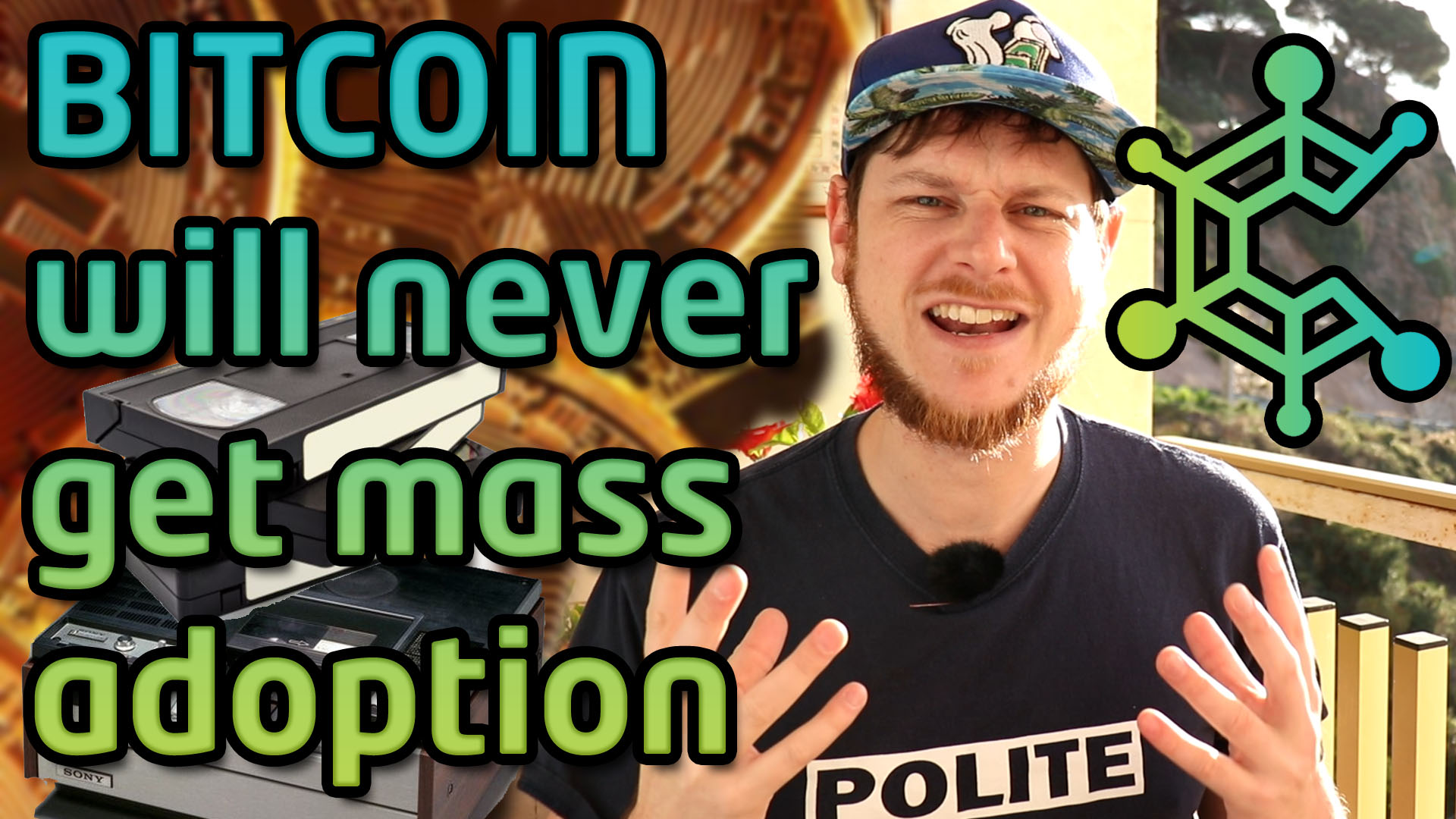
Bitcoin will never reach mass adoption – that’s my case here. It’s not because there’s anything wrong with Bitcoin of itself. It’s simply because Bitcoin isn’t aiming for mass adoption.
The Bitcoin team isn’t focused on mass adoption, and maybe they never were. They’re focused on something else – I don’t know exactly what, something technical, some kind of engineering miracle. I know they’re not focused on mass adoption, because mass adoption comes with user experience. The way you get people to use your tech is to make it easy to use. You start with your customer in mind.
Scroll down to watch and listen to this episode.
Stay Safe
UX is not a priority for Bitcoin
We know that user experience isn’t their priority, because we can hear it from the developers themselves. In 2017 when Bitcoin transaction fees were surging, Bitcoin dev Lukejr said “Just pay a $5 fee and it’ll go through every time unless you’re doing something stupid.”
In 2013, developer Gregory Maxwell gave his opinion on the 1 MB block limit which caused the transaction fees to get to that point, saying he wouldn’t have joined the project if they didn’t have that limit. More recently in October 2018, both Maxwell and developer Jimmy Song advised people to use their credit cards rather than use Bitcoin for a purchase.
We can tell these are people who aren’t striving for a good UX, saying these things without apologies. Whatever plans they have for Bitcoin, it’s not as a payment platform for regular people. Bitcoin has an established history, it’s the oldest project of its kind, and it is tough. I would still say it’s the most stable project in crypto, but I’d also say that stable and stagnant are two sides of the same coin.
I like to think about the case of BetaMax vs VHS, the video systems from the 80s and 90s.

BetaMax vs VHS
The whole product
This is an extract from an article about BetaMax vs VHS:
… almost no journalists, and no geeks, have ever come across the concept of “the whole product”, though it is well known to marketing people. Real people may not be aware of it, but the “whole product” model is an accurate description of the way they buy things.
Let’s take a simple example: digital audio tape (Dat). Get someone to compare Dat with a humble C90 compact cassette and they will find Dat to be technologically superior, especially for recording music. However, if you consider “the whole product”, Dat is vastly inferior for most people most of the time. This is why people still buy millions of cassettes, while Dat has virtually disappeared from consumer use.
The point is that when someone buys and uses a product, the technological aspects are a small and often uninteresting part of the decision. When you choose compact cassette, you are also buying into a vast infrastructure of capabilities, services and support. These include the availability of cheap cassettes on every high street, cheap personal stereos, and the ability to use the same format for a wide range of applications (personal stereo, portable radio/cassette players, in the car, in your hi-fi stack).
That was Jack Schofield writing for the Guardian in 2003. We don’t use cassette tapes any more, but fundamentally nothing has changed. Techies still don’t know that there is more to a product than just its specs.

Go verify your own blockchain
“It comes from an an American culture, so there’s an analogy to the right to bear arms in the Bitcoin world, and that’s the right to be able to validate the blockchain itself … If you can’t download a node to a consumer grade computer and run the verification process, you can’t actually know the supply is limited.”
I respectfully disagree with Juan. if you’re nerdy enough to want to download an entire blockchain and prove for yourself that the amount of coins is limited, you’re probably nerdy enough to buy specialised hardware to do it. Working the whole project to cater to this small group of people who want to be able to prove the basis of their money on their home computer, is backwards. Regular people don’t care about that.
I encourage people to go back and listen to the full interview with Juan so you can hear his arguments and make up your own mind.
Everybody wants a good user experience
Regular people want something easy to use, and to get them to change their habits, it might even have to be easier to use than what they have now. Services like Google Pay, PayPal and Venmo set the standard of modern financial services. Being able to verify the blockchain on your iPhone generally is not something that people have on their mental checklist.
This tech can already be used to send payments cheaply, evading capital controls, and giving an option to people stuck with a hyperinflating currency. There are people suffering out there who could really benefit from digital currency, but they still can’t get it because there aren’t services that let them access it. Fortunately, some people are working on things like Dash Text, which lets people with feature phones send Dash.
I don’t know which project will hit the mainstream first. What I know is, if your project focuses on tech and not people, it will stay in your mum’s garage. First and foremost, all tech, all design, all crypto, should be about people. When you care about people, people will care about you.
Important Links
Buy a Trezor and keep your crypto safe
Steve Jobs on UX
Why VHS was better than BetaMax
Just pay a $5 fee
Greg Maxwell 1 MB limit
Credit cards are better
Juan Galt – Practical Bitcoin Maximalist
Cryptonomics – Bitcoin will NEVER reach mass adoption
You can listen and subscribe on Anchor and other podcasting services here:
